- About us
- Support the Gallery
- Venue hire
- Publications
- Research library
- Organisation chart
- Employment
- Contact us
- Make a booking
- Onsite programs
- Online programs
- School visit information
- Learning resources
- Little Darlings
- Professional learning
Hugh Ramsay (1877–1906), painter, was runner-up for the National Gallery Travelling Scholarship in 1899, and sailed to Europe on the same ship as his fellow artist George Lambert. For fifteen months he painted and partied in a cold, grimy Paris studio, gaining some critical success while depending on the Lamberts for an occasional hot meal. In 1902 four of his paintings were chosen for exhibition at the New Salon, Paris; this extraordinary achievement earned him the patronage of Dame Nellie Melba, a relative of his friend Ambrose Patterson. When Ramsay fell ill, she funded his return to Victoria. Here, he worked hard, amassing works for his sole one-man exhibition (at Melba’s rented home in Toorak) before dying of consumption at the age of twenty-eight. It was widely acknowledged that he had the most brilliant potential of the artists of his generation. ‘Had he lived longer’, said Lambert, ‘he would have beaten the lot of us.’
The many self portraits Ramsay painted in the Paris studio, which are now distributed through the collections of major Australian public galleries, comprise one of the most important series in the history of Australian art. In this characteristically dashing work, Ramsay pays homage to his art heroes, Velasquez and Manet.
Gift of the Estate of John Oswald Wicking 2003
This full-length self-portrait of Australian artist Hugh Ramsay is a slim 102cm x 63 cm oil on canvas with a plain 12cm wide gold frame.
The overall impression is of the artist as a young man in a dark studio space. Ramsay’s body is in profile, he turns to his left, his head facing us. His face and shoulder are brightly illuminated from the right, otherwise the interior is painted indistinct dull browns, beige, greys, and black. In comparison, the texture of the canvas surface varies. Some areas appear speedily painted with thick brushwork and thin streaks of lumpy red and gold, contrasting with the blended flesh tones in the artist’s face.
On the left, behind Ramsay, a beige coloured floor rises steeply to meet stacked, stretched canvas’ leaning against the studio wall. Some are tall and rectangular, there are two, smaller, gold-framed paintings leaning back to back. The scene on the foremost canvas is too dark to read.
In the lower left corner, two identical, small angular shapes project in from the edge of the painting suggesting the wooden feet of a studio easel. A kidney shaped artist’s palette sits on a brown, thinly spoked four-legged stool, it reaches Ramsay’s thigh.
Ramsay’s head is almond shaped. His short, wavy brown hair lies flat on the top of his head, parted in the middle, cut cleanly above his ears. Beige and pink skin tones on the left side of his face contrast with his dark and featureless right side. He has a high and furrowed forehead, his deep-set left eye gazes forward, the shadow line of his long straight nose runs down to his closed mouth.
His jaw is long and pointed; jutting over his high, white shirt collar. The collar is stiff but the shirt, tucked into his trousers, is loose. A lightly knotted black tie delineates the curved profile of his chest and stomach. The generous shirtsleeve of his left arm is folded back above his forearm. His left hand holds a paintbrush and a small grey cloth, relaxed, wrist facing up. Ramsay stands with his legs apart; his right leg supports his weight while at a step distance in front; his left leg is slightly bent at the knee.
The artist wears plus four trousers which are high waisted, black and baggy, finishing beneath his knees. Long, black socks define his calves and merge into slim black shoes. His feet are splayed, at 90-degree angle to one another; the left foot is in profile and behind one of the stool legs, his right foot is facing the easel the artist is working on.
Audio description written by Annette Twyman and voiced by Emma Bedford
Hugh Ramsay (age 24 in 1901)
John O. Wicking (2 portraits)



On one level The Companion talks about the most famous and frontline Australians, but on another it tells us about ourselves.
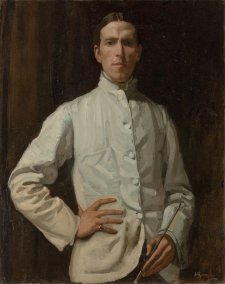
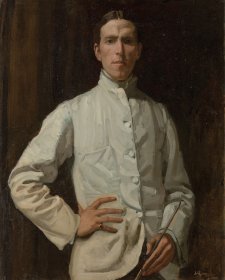
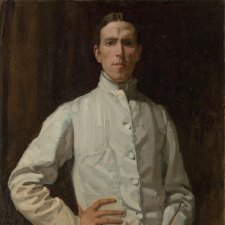
Inga Walton on the brief but brilliant life of Hugh Ramsay.
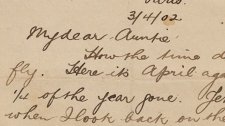
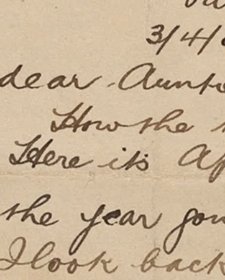
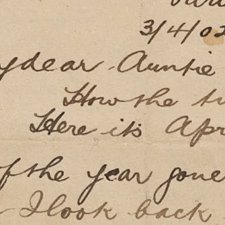
Hugh Ramsay's letters were written while he was living in Paris to his family back in Australia.